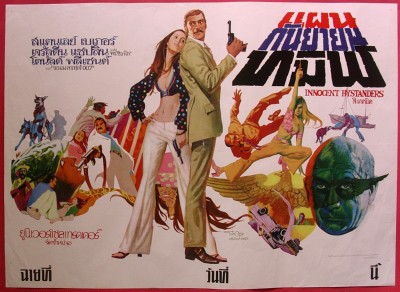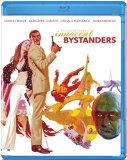| Reviews & Columns |
|
Reviews DVD TV on DVD Blu-ray 4K UHD International DVDs In Theaters Reviews by Studio Video Games Features Collector Series DVDs Easter Egg Database Interviews DVD Talk Radio Feature Articles Columns Anime Talk DVD Savant Horror DVDs The M.O.D. Squad Art House HD Talk Silent DVD
|
DVD Talk Forum |
|
|
| Resources |
|
DVD Price Search Customer Service #'s RCE Info Links |
|
Columns
|
|
|
Innocent Bystanders
An Olive Films release sublicensed from Paramount, Innocent Bystanders utilizes a good transfer of inferior film elements. The image is notably soft and dirty throughout. This may be because while Paramount distributed the film in the U.S. (in 1973), the U.K. distributor was a company called Scotia-Barber, and the original film elements might well be in England and inaccessible to either Paramount or Olive.
The film adapts the last of four John Craig spy novels by James Mitchell, writing under the pseudonym James Munro. Oddly, the film's credits read, "Screenplay by James Mitchell, based on the novel by James Munro," a clever way to get one's name twice on the screen, I suppose.
The picture opens with an atmospheric, exciting prison break from a Siberian gulag, one that suspiciously resembles a World War II era POW camp and might well be redressed sets from The McKenzie Break (1970). Regardless, one of the escapees is Aaron Kaplan (Vladek Sheybal), a brilliant scientist whose desalination experiments promise to turn the world's deserts into rich farmlands. British and American forces scramble to locate him before the KGB does.
In London, the head of Department K, Loomis* (Donald Pleasance) assigns aging spy John Craig (Baker) to the case. But he's had it with the spy game and wants out, especially with younger, ambitious agents like Joanna Benson (Sue Lloyd) and Andrew Royce (Derren Nesbitt) chomping at his heels.
Further, in a strange, confusing scene, Craig is tortured by CIA agent Blake (Dana Andrews), who threatens Craig with an electrocution device similar to what Craig endured when previously held prisoner by the KGB. Blake has the machine unplugged at the last minute, but Craig screams and sweats in agony anyway. Apparently like waterboarding, after Craig's previous experience, even the simulation of electrocution produces the same Pavlovian results.
In "New York" (more about this below), Craig locates Kaplan's brother, Marcus (Ferdy Mayne) and a young woman named Miriam Loman (Geraldine Chaplin), Marcus's ward. Craig kidnaps Miriam, threatening her life and striking out on his own to find Kaplan. The naïve American falls in love with her kidnapper, despite his continual efforts to dissuade her from such foolishness. Meanwhile, Benson and Royce follow Craig first to Turkey and then to Cypress with the Americans and Soviets not far behind.
Interiors were filmed on stages at Pinewood and apparently all of the exteriors were photographed on location in Spain. But while the Spanish landscape approximate Turkey and Cypress reasonably well, it's absurdly unreal standing in for New York City and upstate New York especially, the Mediterranean climate and tiled and mud-brick houses frequently seen in long shots straining credibility well past the breaking point.
Peter Collinson directed. Best known for the hilarious The Italian Job (1969), his talents as a filmmaker appear to have been squandered by his notorious reputation as a screamer constantly at odds with his casts and crews. That partly accounts for his schizophrenic career following The Italian Job. Indeed, just prior to this he made Straight On till Morning (also 1972), Hammer's worst film ever (no small feat), a pretentious, unpleasant disaster. As in many of his other films from this period, Collinson employs sometimes gimmicky, other times clever editing flourishes and a dark, cynical sense of humor that pays off once in a while. Craig's violent rivalry with Benson and Royce is funny, for instance, and near the beginning of the film there's an amusing bit with a subtly insistent Loomis treating Blake to a grotesque meal at his club.
Wisely, the film restricts all this eccentricity to supporting characters like Warren Mitchell's hilariously Aussie-accented Turk, while keeping Craig grimly determined to find Kaplan and a way out of Department K. Stanley Baker's performance is very good, despite a distractingly bushy mustache and painfully obvious toupee. During one especially unreal fight scene in a drained swimming pool, the long hair of Baker's stunt double resembles Baker's helmet-like rug not at all.
Video & Audio
Innocent Bystanders is presented in 1.78:1 widescreen, approximating its original aspect ratio, somewhere between 1.66:1 and 1.85:1, though I didn't notice any awkwardly tight framing if 1.66:1 was intended. The image is film-like but very soft throughout, especially title elements, dissolves, and other optical effects, and there are signs of minor damage, including single-frame blue blotches. I was surprised to read one review acknowledge these problems, adding, "the transfer exhibits an overall softness which may in fact simply reproduce what was probably a pretty low budget affair to begin with." Huh? Since when does a film's negative cost effect picture sharpness? Rather than single this review out for scorn I note a completely groundless complaint I often see in reviews, that low budgets explain away bad transfers and/or the use of inferior film elements. In fact huge budget movies sometimes look terrible on Blu-ray while extremely low-budget movies often look fantastic. Except in extreme cases, such as wartime Japan's use of inferior film stock during 1943-45) one has nothing to do with the other. The audio, mono English only with no subtitle options is adequate and there are no Extra Features.
Parting Thoughts
Not bad, not great, Innocent Bystanders was among the very last gasps of the '60s-style spy film, of which this is a decent if not particularly memorable example. Very mildly Recommended.
* Contemporary reviews always note that Pleasance's character has the same name as his Halloween film series character. However, in Innocent Bystanders for some reason everyone, including Loomis himself, pronounce it "Looms."
Stuart Galbraith IV is a Kyoto-based film historian whose work includes film history books, DVD and Blu-ray audio commentaries and special features. Visit Stuart's Cine Blogarama here.
|
| Popular Reviews |
| Sponsored Links |
|
|
| Sponsored Links |
|
|
| Release List | Reviews | Shop | Newsletter | Forum | DVD Giveaways | Blu-Ray | Advertise |
|
Copyright 2024 DVDTalk.com All Rights Reserved. Legal Info, Privacy Policy, Terms of Use,
Manage Preferences,
Your Privacy Choices | |||||||















